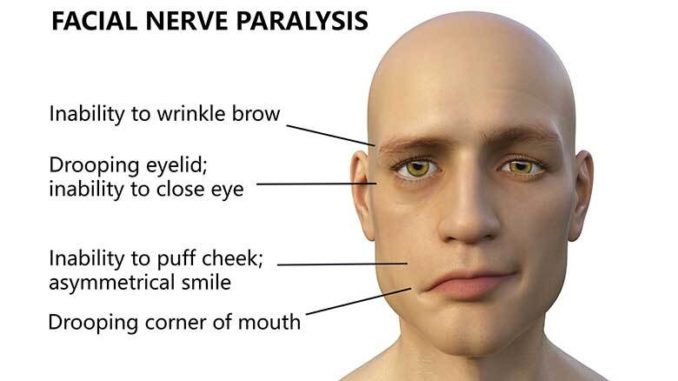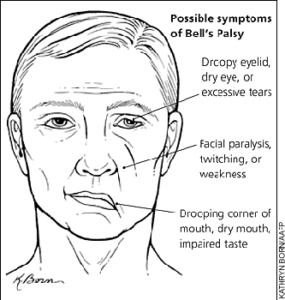
Table of Contents
What is Facial Palsy?
- The term “facial palsy” refers to facial muscle weakness caused by injury to the face nerve (the 7th cranial nerve), which can be temporary or permanent.
- Facial palsy is also known as facial paralysis.
- The muscles of the face do not receive the required signals to function properly when a facial nerve is either non-functioning or absent.
- The affected section of the face becomes paralyzed, affecting movement of the eye(s), mouth, and other parts of the face.
Causes of Facial Palsy
Although Bell’s palsy is the most well-known cause of facial paralysis, there are many distinct causes of facial paralysis, and treatment and prognosis varied widely depending on the cause. Some of the most common causes of facial palsy are as follows:
- Ramsay Hunt syndrome, a viral illness.
- Surgical causes: for example, when a facial nerve tumor is removed, or when the parotid gland is operated on.
- Bacterial causes: such as Lyme disease or a middle ear infection.
- Neurological illnesses like neurofibromatosis 2 and Guillain-Barré syndrome.
- Traumatic injuries, such as fractures of the brain, skull, or face
- Birth trauma, such as the one induced by forceps or a facial presentation delivery.
- Congenital disorders include faulty face nerve or muscle development in the womb.
- Moebius syndrome and CHARGE syndrome are two rare genetic syndromes.
- Bell’s palsy is an idiopathic disorder, which means that no definite cause has been identified, though ties to viruses have been made.
- Although a stroke can induce facial palsy, the issues are not caused by direct injury to the face nerve. In this situation, the paralysis is due to brain injury and improper message transmission to the facial nerve.
Risk Factors of Facial Palsy
- Diabetes
- Pregnancy
- Potentially as a result of hypercoagulability, elevated blood pressure and fluid load, viral infections, and reduced immunity
- Infection in the ear
- Infection of the upper respiratory tract
- Obesity
Types of Facial Palsy
- Central nerve palsy
- Peripheral nerve palsy
Symptoms of Facial Palsy
- Rapid development of slight weakness to complete paralysis on one side of your face, which can happen in hours or days.
- Face drooping and trouble producing facial emotions such as smiling or closing your eyes
- Drooling
- On the affected side, pain around the jaw or in or behind the ear
- On the affected side, increased sensitivity to sound
- Headache
- Changes in your tear and saliva production
- A loss in taste specially in the front two-thirds of the tongue
- In the damaged ear, there is a hypersensitivity to sound (hyperacusis)
- Inability to close one’s eye on the affected side of the face
Diagnosis of Facial Palsy
- Symptoms are usually enough for a healthcare provider to diagnose facial palsy. There are no particular tests for facial palsy diagnosis.
- However, doctor may arrange tests to rule out other conditions that cause similar symptoms and to determine the extent of nerve damage or involvement. These tests may involve the following:
- Electromyography (EMG) is used to determine the extent of nerve involvement.
- Blood tests will be performed to see whether there is anything else going on, such as diabetes or Lyme disease.
- A Magnetic Resonance Imaging (MRI) or Computed Tomography (CT) scan will be used to see if your symptoms are due to a structural issue.
Complications
- Dural tear
- Conductive or sensory neural hearing loss
- Vestibular function loss
- Persistent CSF leak
- Meningitis
- Injury to cerebral artery
Treatment
- Patient reassurance is necessary, since most cases recover to full function on their own. One of the most crucial aspects of treatment is eye care, which includes ensuring that the patient uses lubricating drops on a regular basis and considering the use of eye ointment and/or an eye patch at night.
- The cause of facial palsy determines the medical and surgical treatment options.
- Within 72 hours of start, corticosteroids (prednisone) are administered. Antiviral medication may be used in conjunction with this.
- A variety of surgical treatments may be performed for patients with dense facial palsy and no nerve function.
- Surgical resection of tumors is common. Oculoplastic surgery may be recommended for patients who are at high risk of developing a corneal ulcer.
More About Common Causes of Facial Palsy
Bell’s palsy
- Bell’s palsy is a condition in which one side of the face becomes weak or paralyzed for no apparent reason.
- Symptoms usually occur over a period of several hours. The drooping of the affected side of the face is common. Changes in saliva and tear production, as well as the sensation of taste, may occur.
- Many patients believe they are suffering a stroke, but Bell’s palsy is more likely if the weakness or paralysis is limited to the face.
Ramsay Hunt Syndrome
- Ramsay Hunt Syndrome is a Herpes Zoster oticus in which the varicella zoster virus is reactivated from the geniculate nucleus, the nucleus of the facial nerve, resulting in a unilateral facial palsy.
Lyme disease
- Lyme disease is a bacterial infection carried by infected ticks to people.
- The bacteria that cause Lyme disease can harm joints and the neurological system, particularly the facial nerve.
- The infected person may have weakening or paralysis of the facial muscles, usually on one side of the face, if the facial nerve is affected. This is known as ‘facial palsy’
References and For More Information
https://www.mayoclinic.org/diseases-conditions/bells-palsy/symptoms-causes/syc-20370028
https://www.physio-pedia.com/Facial_Palsy
https://www.verywellhealth.com/bells-palsy-and-stroke-3145940
